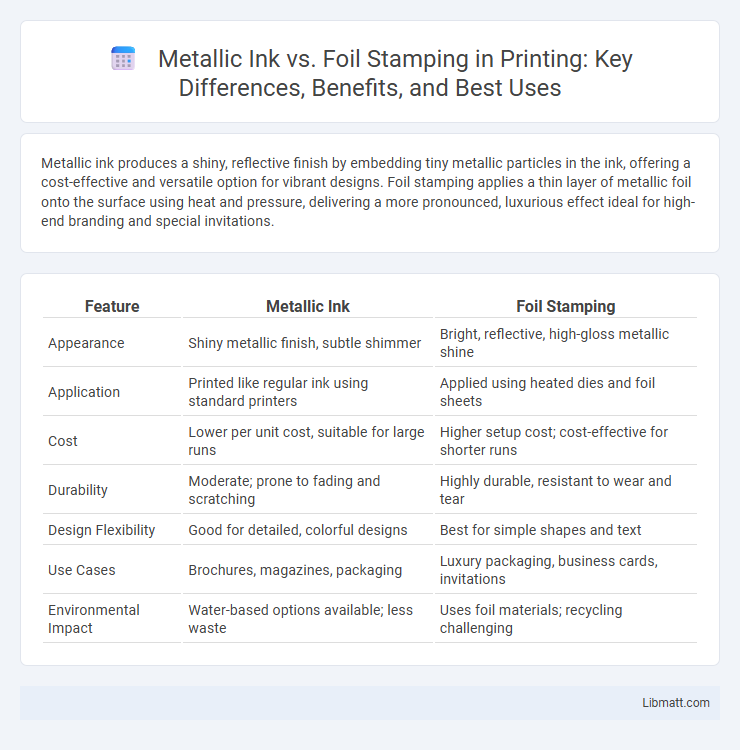Metallic ink produces a shiny, reflective finish by embedding tiny metallic particles in the ink, offering a cost-effective and versatile option for vibrant designs. Foil stamping applies a thin layer of metallic foil onto the surface using heat and pressure, delivering a more pronounced, luxurious effect ideal for high-end branding and special invitations.
Table of Comparison
| Feature | Metallic Ink | Foil Stamping |
|---|---|---|
| Appearance | Shiny metallic finish, subtle shimmer | Bright, reflective, high-gloss metallic shine |
| Application | Printed like regular ink using standard printers | Applied using heated dies and foil sheets |
| Cost | Lower per unit cost, suitable for large runs | Higher setup cost; cost-effective for shorter runs |
| Durability | Moderate; prone to fading and scratching | Highly durable, resistant to wear and tear |
| Design Flexibility | Good for detailed, colorful designs | Best for simple shapes and text |
| Use Cases | Brochures, magazines, packaging | Luxury packaging, business cards, invitations |
| Environmental Impact | Water-based options available; less waste | Uses foil materials; recycling challenging |
Understanding Metallic Ink and Foil Stamping
Metallic ink contains fine metallic particles that reflect light, providing a shimmering finish ideal for detailed graphics and color gradients. Foil stamping uses heat and pressure to apply a thin foil layer, creating a highly reflective, tactile effect perfect for logos and text with crisp edges. You can choose metallic ink for vibrant, colorful designs, while foil stamping offers a premium, polished look that stands out with its texture and shine.
Key Differences Between Metallic Ink and Foil Stamping
Metallic ink offers a subtle shimmer by incorporating tiny metallic particles into the ink, creating reflective effects directly on the printed surface, whereas foil stamping applies a thin layer of metallic foil using heat and pressure, resulting in a more vibrant and textured finish. Foil stamping tends to produce sharper, more durable metallic highlights ideal for luxury branding, while metallic ink is more cost-effective and suitable for large runs with moderate shine. Your choice depends on the desired visual impact, budget constraints, and print volume, with foil stamping excelling in premium applications and metallic ink offering versatility.
Visual Impact: Metallic Shine vs Foil Luster
Metallic ink creates a subtle shimmer with its reflective pigments, offering a smooth, integrated shine that enhances detailed graphics and fine text. Foil stamping delivers a bold, mirror-like luster that stands out with its high contrast and tactile depth, making it ideal for premium branding and luxury designs. The choice between metallic ink and foil stamping depends on whether a soft metallic glow or a striking, glossy finish is desired for visual impact.
Durability and Longevity of Both Finishes
Metallic ink offers moderate durability with resistance to fading and smudging, making it suitable for short to medium-term projects. Foil stamping provides superior longevity due to its resilient metallic layer, which maintains shine and withstands wear, perfect for high-end packaging or promotional materials. When choosing finishes, consider Your project's exposure to handling and environmental conditions to ensure lasting visual impact.
Cost Comparison: Metallic Ink vs Foil Stamping
Metallic ink generally offers a more cost-effective option than foil stamping, with lower setup fees and printing expenses, making it ideal for budget-conscious projects. Foil stamping involves higher costs due to the need for custom dies and specialized equipment, but it delivers a more durable and vibrant finish. Choosing between metallic ink and foil stamping depends on budget constraints and the desired visual impact for packaging or promotional materials.
Design Flexibility and Application
Metallic ink offers greater design flexibility with a wide range of colors and gradients that can be printed on various surfaces, making it ideal for intricate and detailed designs. Foil stamping provides a high-impact, reflective finish that stands out on premium materials, but is limited to single-color or two-tone effects and requires specific application methods. Both techniques are used in packaging, invitations, and branding, but metallic ink adapts better to complex graphics while foil stamping excels in creating elegant, eye-catching highlights.
Printing Process: How Metallic Ink and Foil Stamping Work
Metallic ink involves mixing metallic particles with regular inks, which are then applied directly to the surface using standard printing methods such as screen or offset printing, creating a shiny, reflective finish. Foil stamping uses heat, pressure, and a metallic foil transfer to bond thin layers of metallic foil onto the substrate, resulting in a brighter and more textured metallic effect. Understanding these processes helps you choose the best technique for your project's desired look and durability.
Ideal Use Cases for Metallic Ink
Metallic ink is ideal for creating vibrant, reflective designs on packaging, labels, and promotional materials where a subtle shimmer enhances brand appeal without the added cost of foil stamping. It works well on a variety of substrates, including paper, plastic, and cardboard, making it versatile for marketing collateral and product packaging. Your designs benefit from metallic ink when you need an eye-catching, cost-effective solution for highlighting logos, text, or decorative elements.
Best Projects for Foil Stamping
Foil stamping is ideal for luxury business cards, wedding invitations, and premium packaging, creating a rich, tactile metallic finish that elevates your design's elegance. Unlike metallic ink, foil stamping delivers vibrant, reflective colors with crisp, embossed details that capture attention and convey sophistication. Choose foil stamping for projects requiring lasting visual impact and a high-end, handcrafted feel.
Which to Choose: Metallic Ink or Foil Stamping?
Choosing between metallic ink and foil stamping depends on your project's budget, design complexity, and desired finish. Metallic ink offers a cost-effective option with subtle shimmer ideal for large runs and intricate details, while foil stamping provides a highly reflective, luxurious look perfect for premium branding and small batches. Consider your target audience and printing method to ensure your project achieves the right visual impact with either your metallic ink or foil stamping choice.
Metallic Ink vs Foil Stamping Infographic

 libmatt.com
libmatt.com